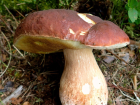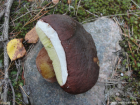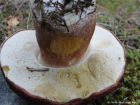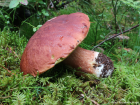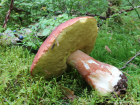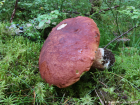Cap deep red-brown or copper coloured. Stays convex for a while, but eventually flattens out. Often irregular in shape when mature. The surface is hard, dimpled and rough and sticky when damp. The flesh is white, tinged cap colour beneath the cuticle, unchanging, thick, fairly firm. Pores white then cream-coloured, becoming olivaceous-brown with age, circular and small. Stem thick and egg or pear-shaped when young. The network pattern is dark brown at the bottom and gets lighter towards the cap. Flesh white, unchanging and fairly firm. The stem has no ring. Spore print olive brown.
Microscopic Features: The spores are fusiform, smooth, and have dimensions of 13-18 x 4-5.5µm, which is notably narrower compared to those of Boletus edulis.
Similar species include Boletus edulis that has brown cap colour and Tylopilus felleus which is similar when young but tastes bitter.
Boletus pinophilus on the First Nature website.
Boletus pinophilus on Wikipedia.
Many mushrooms are poisonous, and some can be lethally toxic. Distinguishing between edible and poisonous mushrooms can be very challenging. Therefore, we strongly advise against consuming wild mushrooms. This website does not contain any information about the edibility or toxicity of mushrooms.
Although efforts have been made to ensure accuracy on this website, the information may contain errors and omissions. Therefore, all content provided is for educational and informational purposes only and should not be relied upon or used as a basis for consuming any plants or mushrooms.
External links are provided for reference only. We do not endorse or take responsibility for the content, advice, or products found on these sites or in any advertisements shown on this website.

